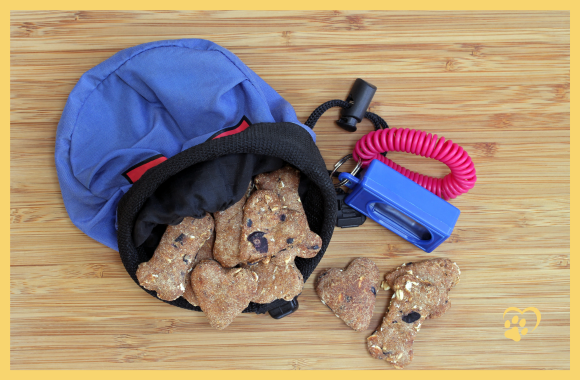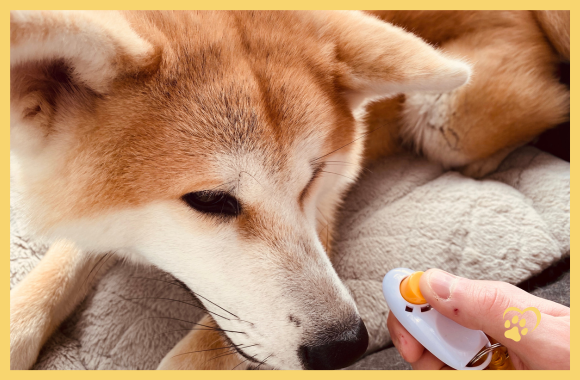You may have noticed that communication between you and your dog is not always smooth. Successful clicker training can be the solution. We will take a close look at the most common problems with clicker training and present you with tried and true solutions. We will focus on clear signals, patience, realistic expectations, consistency and the right rewards. Whether you're just getting started with clicker training or you've been using it for a while and want to improve, this article will help you master this method.
What you should know about clicker training
The emergence of clicker training
Did you know that clicker training has its origins in working with marine animals? In the 1960s, animal trainers were looking for a way to train dolphins and whales that were not always in close proximity. This is where the clicker came into play. This simple device produces a clear, distinctive sound that is independent of the human voice. The click became a signal for a correctly performed behavior and was always associated with a reward.
The theory behind the clicker
The idea of clicker training is as simple as it is ingenious. The click serves as a so-called "bridge stimulus" that shows the dog exactly when he has done something right. Basically, it's like instant praise that bridges the gap between the desired behavior and the subsequent reward. This immediate praise makes it easier for your dog to understand what you want him to do.
Advantages and disadvantages of clicker training
Clicker training has many advantages. It is a gentle, non-violent method based on positive reinforcement. It improves communication between you and your dog and makes learning a fun game. But as with everything in life, there are challenges. Some dogs are afraid of the click sound or it may take some practice to find the right time to click. It also takes some consistency and patience to see the first successes.
The problem with unclear signals
Perhaps you've experienced this too: you give your dog a command, but instead of showing the desired behavior, he just looks at you in confusion. Unclear signals are a common problem in clicker training. This can be because we humans sometimes forget that our four-legged friends don't understand our language. They respond to our body language, tone of voice, and repetitive signals. If these signals are inconsistent or unclear, your dog can quickly become confused.
The solution: clarity in communication
How can this problem be solved? The answer lies in clear and unambiguous communication. Think of it like a traffic light: Red means stop, green means go. There are no gray areas. This is exactly how it should be in communication with your dog.
When you train your dog, every command, gesture, and click should be unique. A "sit" command should always look and sound the same, whether you're in the kitchen or the park. And the click should always occur exactly when your dog is performing the desired behavior - not a second earlier or later.
Did you know that dogs can learn up to 250 words and gestures? Use this potential and make your communication as clear and unambiguous as possible. This way your dog will quickly understand what you expect from him and you will notice how your training successes improve.

The problem: impatience in training
It's human and it happens to all of us: Sometimes we just want to see results quickly. Especially when you start a new project like clicker training with a lot of enthusiasm and good intentions. However, impatience in training can lead to frustration - both for you and your dog.
Learning takes time. Your dog must first understand what the clicker means and what behavior leads to a reward. This does not happen overnight.
The solution: patience
Patience is the key to success. And the beauty is: patience can be practiced and improved. Dogs live in the here and now. They don't worry about the future or fret about the past. They take each moment as it comes. Perhaps we can learn from our four-legged friends and be similarly patient and present in training.
Try to see training as a shared time of learning and discovery, rather than a task that must be completed as quickly as possible. Celebrate small successes and be patient with setbacks. And remember: even if it doesn't seem like it sometimes, your dog is always doing his best.
By the way, did you know that according to research, the reward center in our brain is activated when we are patient and wait for a reward? So patience can actually make you happy! So take the time you need for yourself and your dog.
You can also find more information about clicker training in the following articles:
- Clicker training for dogs: how it works and why it is so effective

- Mastering clicker training: The most important do's and don'ts to make it a success.

- The Basics of Clicker Training for Puppies: The Guide to Getting Started Right

The dilemma of unrealistic expectations
It's easy to be fascinated by the numerous videos in which dogs perform incredible tricks or master complex tasks. Yet it's easy to forget that months of consistent training often lie behind these feats. Unrealistic expectations can quickly lead to frustration and disappointment, both for you and your dog.
Dogs have a very different learning speed, just like us humans. Some learn quickly, others take longer. Every dog is unique and that's part of the fun!
The solution: Set realistic goals
To avoid disappointment and keep the fun in training, it is important to set realistic goals. Start with simple exercises and increase step by step. Celebrate every little progress and do not compare your dog with others.
A good method is to set short and long term goals. A short-term goal might be that your dog responds to the clicker and understands that a click means a reward. A long-term goal might be that your dog understands and performs a series of commands.
Did you know that goal setting can increase motivation and self-confidence, according to studies? It also promotes patience and perseverance - skills that both you and your dog need for successful training. So set realistic goals together with your four-legged friend and enjoy your time together!

The problem: Inconsistent learning
Imagine learning a new language and the rules keep changing. Confusing, isn't it? That's exactly what can happen if your training with your dog is inconsistent. An irregular training schedule, different commands for the same behavior, or different responses to the same behavior can confuse your dog and make training difficult.
Dogs are very sensitive to consistency and routine. They find security and confidence in familiar patterns and behaviors. Therefore, consistency in training is important not only for your dog's learning success, but also for his well-being.
The solution: consistency in training
Consistency in training means sticking to a set training plan, communicating clearly and without contradiction, and responding the same way to the same behavior. It also means that all family members and people who interact with the dog respond in the same way. Consistency builds clarity and trust, two important factors in successful clicker training.
It's a good idea to create a training plan and agree on what commands and signals you will use and how you will respond to certain behaviors. Dogs can remember an impressive number of words, gestures and signals. Take advantage of this and create a "vocabulary list" for your training.
Remember: consistency is not a sign of severity, but of love and respect for your dog. It shows him that you care about his well-being and are willing to invest time and effort into his education. So be consistent and enjoy the progress you and your dog make together!
The problem: lack of reinforcement and reward
Rewards are at the heart of clicker training. They motivate the dog to repeat certain behaviors and help him learn new ones. If the reinforcement is absent or the reward is not appropriate, your dog may lose interest or become confused.
Can you believe that there are actually dogs that respond better to praise and petting than to treats? Every dog is different and it is important to find out what motivates him the most.
The solution: appropriate reinforcement and reward
The key to successful reinforcement in clicker training is to figure out what motivates your dog the most and target those rewards. This can be food, but also toys, praise or petting.
It is also important to give the reward immediately after the click, so that the dog understands the connection between his behavior and the reward. And here's a little surprise: sometimes varying the reward can increase your dog's interest and make training even more effective.
But remember: rewards should always be appropriate. Too many treats can lead to weight problems and too much praise can overwhelm your dog. Find the right balance and make sure your dog finds training a positive and rewarding experience.
So take the time to find out what really motivates your dog and target those rewards to ensure successful clicker training!
Have the courage to implement!
With the right approaches, you can easily master the challenges of clicker training. Make these tips your own and enjoy the positive changes. Training that is tailored to you and your dog will produce the right results.
Dare and discover the joy of learning together. Good luck!
